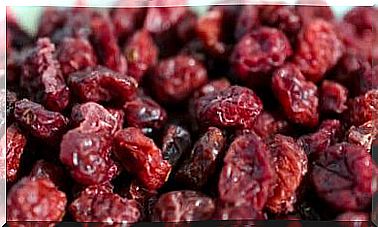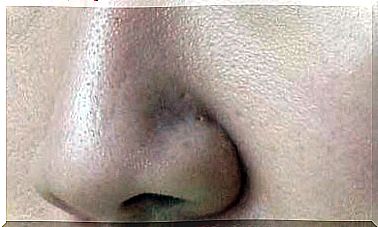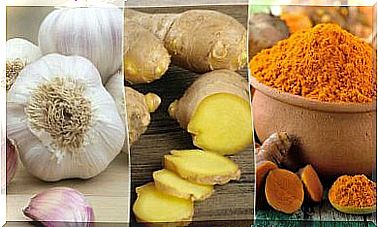Vomit: What Can It Mean According To The Color?
Vomiting is an act that everyone has performed at least once in their life. It has different causes. Do you want to know what it can mean according to its color? Keep reading!

Vomiting is a symptom that anyone can have at some point in their life. It is a sign of many diseases. The causes can range from self-limited clinical pictures to life-threatening conditions.
This symptom is defined as the expulsion through the mouth of the contents of the upper digestive system, as a result of the contraction of the diaphragm and abdominal muscles. The appearance can be due to both gastrointestinal conditions and external situations, such as migraine headaches and pregnancy.
The physical characteristics of the expelled content, such as its color and consistency, can guide the specialist when establishing a diagnosis. This is because the different pathologies give vomit a particular appearance.
Yellow or green vomit
Yellow or greenish discoloration in vomit is indicative of the presence of bile. Bile is a substance synthesized in the liver and released in the upper duodenum. The main function is to digest fats and facilitate the absorption of nutrients.
In most cases it occurs when the stomach is empty, as in the case of intestinal viruses or morning sickness. On the other hand, it also appears in pathologies that occur with repeated vomiting that can empty the stomach, such as intestinal obstruction.
Other causes why vomiting may turn green or yellowish are the following:
- Presence of mucus or catarrh, especially in children.
- Liver failure.
- Intake of food or beverages that can stain the gastric content.
- Poisoning.

Black vomit
The presence of black vomit is a clinical symptom called hematemesis and indicates the presence of digested blood in the stomach. It is important to remember that red blood cells contain iron, which can turn black when subjected to the action of gastric juices.
Hematemesis appears in all those pathologies that present with upper gastrointestinal bleeding. According to research, the mortality rate in these patients is low. In fact, up to 65% remit on their own. In most cases the bleeding produced is slight. The appearance is blackish and many people describe it as similar to dark brown.
Among the main pathologies capable of causing black vomit, the following stand out:
- Mallory-Weiss syndrome.
- Rupture of esophageal varices.
- Stomach or esophageal ulcers
- Crohn’s disease.
- Stomach cancer
Brown vomit
The brown color in vomit has 2 probable causes. The first of these is a hematemesis in which gastric juices did not affect iron to a great extent, so it did not reach the black hue.
The second probable cause is a severe intestinal obstruction, most often in the distal part of the gastrointestinal tract. This condition is capable of preventing the digestion of food. Vomit is usually a brownish color that is very similar to stool.
When it is the product of an intestinal obstruction, it is known as fecaloid , due to the smell of feces it produces. This is considered an unequivocal sign of the pathology, since it occurs between 80% and 100% of cases, according to studies.
White or foamy vomit
Foamy vomit is produced by those pathologies that occur with irritation of the gastric mucosa and stomach gases. The presence of oxygen and other gaseous compounds in the stomach causes the appearance of bubbles or foam.
In this sense, diseases such as gastritis and gastroesophageal reflux can cause symptoms. These conditions are not life threatening and vomiting should subside on its own after a few days.
The white color can only be given by the ingestion of foods such as milk or ice cream, so it is not a sign of concern. For its part, vomit can also be clear or transparent, which appears in the same circumstances as green or yellow.
Orange vomit
Orange is the characteristic color of partially digested food, so it is possible to notice this hue in the first vomiting that occurs. Almost all digested foods have an orange hue when gastric juices exert their action on them.
Orange vomit usually appears during a certain period and then acquires any of the tones already described. Some of the situations that can cause it are the following:
- Food poisoning.
- Stomach flu.
- Migraines
- Pregnancy.
- Chemotherapy.
Red or bloody vomit
A red or pink hue in vomit can only indicate the presence of fresh, undigested blood. This form of presentation is also called hematemesis, according to the Spanish Association of Pediatrics, although it does not present the characteristic black color.
The coloration is indicative of the presence of profuse upper gastrointestinal bleeding and represents a medical emergency. Any pathology capable of causing upper gastrointestinal bleeding may generate red or bloody vomit. In this sense, the triggering factor may be a more severe presentation of the lesions that cause black vomit.

Complications associated with vomiting
One of the main complications associated with vomiting is dehydration and electrolyte disturbances, especially in young children. Constant vomiting implies a great loss of water from the body.
Another complication is aspiration or aspiration of vomit into the lungs. The esophagus can also be irritated by the action of gastric juices. Also, the force of vomiting is so abrupt that it can tear the esophageal mucosa.
When vomiting is chronic, it is capable of causing malnutrition in people. This is because they prevent the proper digestion of food and the subsequent absorption of nutrients.
The color of vomit is very important
The importance of the color of the vomit lies in the fact that it can guide the doctor when diagnosing the causative pathology. Therefore, the specialist will emphasize knowing the color of the expelled material and thus determine if it is an emergency.
In most cases it is not a cause for alarm and usually disappears after a few days. However, it is important to see a doctor when blood or fecal matter is expelled, as both situations can be life-threatening.









